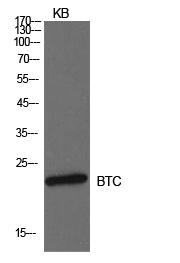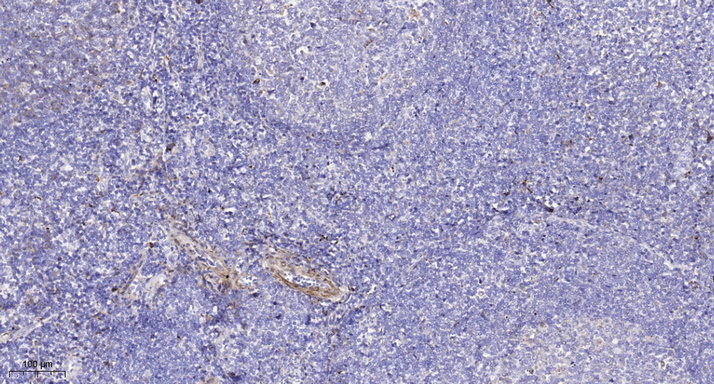Probetacellulin Polyclonal Antibody
- Catalog No.:YT5642
- Applications:WB;ELISA;IHC
- Reactivity:Human;Mouse
- Target:
- Probetacellulin
- Fields:
- >>ErbB signaling pathway
- Gene Name:
- BTC
- Protein Name:
- Probetacellulin
- Human Gene Id:
- 685
- Human Swiss Prot No:
- P35070
- Mouse Gene Id:
- 12223
- Mouse Swiss Prot No:
- Q05928
- Immunogen:
- The antiserum was produced against synthesized peptide derived from the Internal region of human BTC. AA range:21-70
- Specificity:
- Probetacellulin Polyclonal Antibody detects endogenous levels of Probetacellulin protein.
- Formulation:
- Liquid in PBS containing 50% glycerol, 0.5% BSA and 0.02% sodium azide.
- Source:
- Polyclonal, Rabbit,IgG
- Dilution:
- WB 1:500-2000;IHC 1:50-300; ELISA 2000-20000
- Purification:
- The antibody was affinity-purified from rabbit antiserum by affinity-chromatography using epitope-specific immunogen.
- Concentration:
- 1 mg/ml
- Storage Stability:
- -15°C to -25°C/1 year(Do not lower than -25°C)
- Other Name:
- BTC;Probetacellulin
- Observed Band(KD):
- 20kD
- Background:
- This gene encodes a member of the epidermal growth factor (EGF) family of proteins. Alternative splicing results in multiple transcript variants, at least one of which encodes a preproprotein that is proteolytically processed to generate the secreted growth factor. A secreted form and a membrane-anchored form of this protein bind to multiple different EGF receptors. This protein promotes pancreatic cell proliferation and insulin secretion, as well as retinal vascular permeability. Mutations in this gene may be associated with type 2 diabetes in human patients. [provided by RefSeq, Nov 2015],
- Function:
- disease:Betacellulin from beta cells could play a role in the vascular complications associated with diabetes.,function:Potent mitogen for retinal pigment epithelial cells and vascular smooth muscle cells. The effects of betacellulin are probably mediated by the EGF receptor and other related receptors.,similarity:Contains 1 EGF-like domain.,subunit:Monomer.,tissue specificity:Synthesized in several tissues and tumor cells. Predominantly expressed in pancreas and small intestine.,
- Subcellular Location:
- [Betacellulin]: Secreted, extracellular space.; [Probetacellulin]: Cell membrane; Single-pass type I membrane protein.
- Expression:
- Synthesized in several tissues and tumor cells. Predominantly expressed in pancreas and small intestine.
- June 19-2018
- WESTERN IMMUNOBLOTTING PROTOCOL
- June 19-2018
- IMMUNOHISTOCHEMISTRY-PARAFFIN PROTOCOL
- June 19-2018
- IMMUNOFLUORESCENCE PROTOCOL
- September 08-2020
- FLOW-CYTOMEYRT-PROTOCOL
- May 20-2022
- Cell-Based ELISA│解您多样本WB检测之困扰
- July 13-2018
- CELL-BASED-ELISA-PROTOCOL-FOR-ACETYL-PROTEIN
- July 13-2018
- CELL-BASED-ELISA-PROTOCOL-FOR-PHOSPHO-PROTEIN
- July 13-2018
- Antibody-FAQs
- Products Images

- Western Blot analysis of KB cells using Probetacellulin Polyclonal Antibody. Secondary antibody(catalog#:RS0002) was diluted at 1:20000
.jpg)
- Western Blot analysis of KB cells using Probetacellulin Polyclonal Antibody. Secondary antibody(catalog#:RS0002) was diluted at 1:20000

- Immunohistochemical analysis of paraffin-embedded human tonsil. 1, Antibody was diluted at 1:200(4° overnight). 2, Tris-EDTA,pH9.0 was used for antigen retrieval. 3,Secondary antibody was diluted at 1:200(room temperature, 45min).


